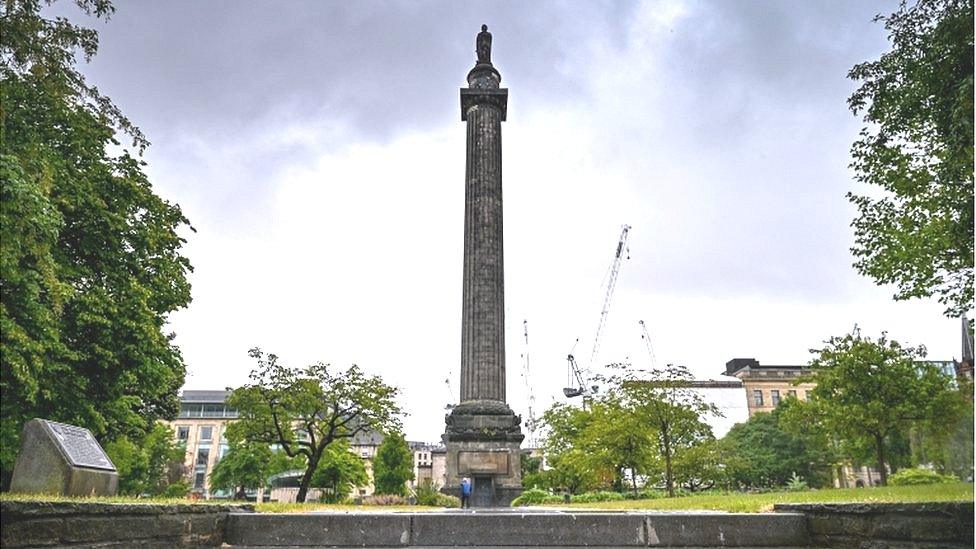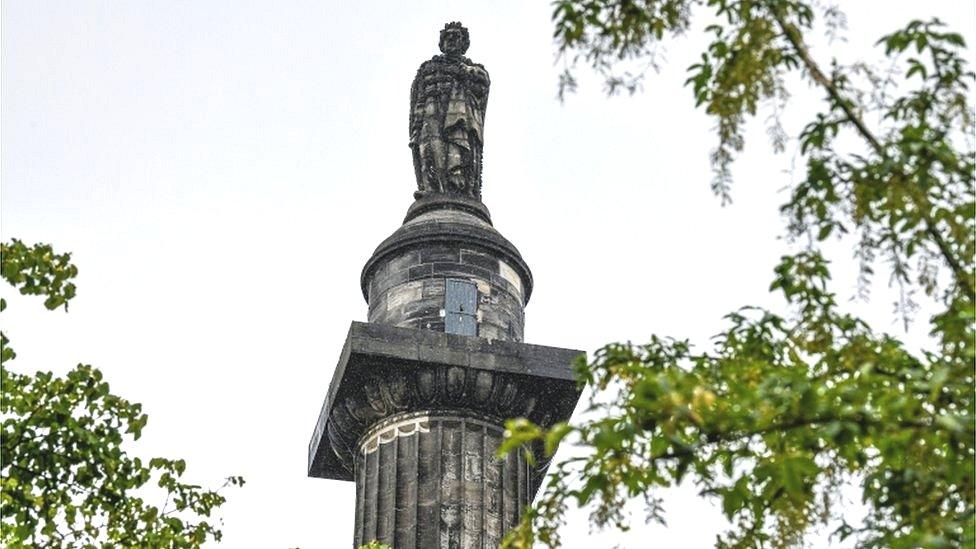Edinburgh's Dundas statue to be dedicated to slavery victims
- Published

The statue of Dundas sits on a tall column in St Andrew Square
The City of Edinburgh is proposing to dedicate a controversial 1827 Henry Dundas monument to those enslaved because of his actions.
New signage will explain that Dundas was "instrumental in deferring the abolition of the Atlantic slave trade".
The statue on a tall column in Edinburgh's St Andrew Square was funded by voluntary subscription.
Council leader Adam McVey said it was important to highlight "the good and the bad" of Edinburgh's story.
A City of Edinburgh Council committee will consider the plan on Thursday.
A number of cities have been reviewing the way in which public statues glorify figures associated with slavery and the colonial era, after a series of Black Lives Matter demonstrations.
In Bristol, a statue of slave trader Edward Colston was removed by protesters on Sunday.

The statue of Edward Colston was thrown into Bristol harbour
Henry Dundas, the first Viscount Melville, died in 1811.
He was a controversial figure during his own lifetime, a defender of the British Empire and its expansion.
He also faced accusations concerning the misappropriation of public money.
Mr McVey said: "This discussion will rightly continue and it's important to listen to black and ethnic minority voices in our city in that discussion.
"This is only one step of many in helping us talk about, understand and confront our history."
If approved, the statue and column in Edinburgh's New Town will be dedicated to the Africans enslaved by Dundas's actions.

How will Edinburgh explain the Dundas statue?

The signage for the monument will say:
"This represents Henry Dundas, 1st Viscount Melville (1742 - 1811). He was the Scottish Lord Advocate and an MP for Edinburgh and Midlothian, and the First Lord of the Admiralty.
"Dundas was a contentious figure, provoking controversies that resonate to this day. While home secretary in 1792 and first Secretary of State for War in 1796 he was instrumental in deferring the abolition of the Atlantic slave trade.
"Slave trading by British ships was not abolished until 1807. As a result of this delay, more than half a million enslaved Africans crossed the Atlantic. Dundas also curbed democratic dissent in Scotland.
"Dundas both defended and expanded the British empire, imposing colonial rule on indigenous peoples. He was impeached in the United Kingdom for misappropriation of public money and although acquitted, he never held public office again.
"Despite this, the monument before you to Henry Dundas was funded by voluntary contribution from officers, petty officers, seamen and marines and erected in 1821, with the statue placed on top in 1827.
"In 2020 this was dedicated to the memory of the more than half a million Africans whose enslavement was a consequence of Henry Dundas's actions."

As council leader, Mr McVey said he understood those who wanted such statues removed entirely but said a fuller understanding of history could be used to tackle prejudice.
"We need to make sure any steps we take serve to educate and highlight all sides of Edinburgh's story - the good and the bad," he said.
"We should not hide from that.
"It's important to also recognise the issues we have now and in understanding our history, we can help tackle prejudice in Edinburgh in 2020."
The 10th Viscount Melville, Bobby Dundas, urged people to delve deeper into his ancestor's history.
"We're talking about a plaque that's going to go on the side of a bit of stone. This is a very controversial period in Scottish history and there needs to be wider information available.
"From what I understand, Henry Dundas was an abolitionist. He provided the word 'gradual' so it would get through legislation and became law, and without that, it wouldn't have passed for decades.
"You need to judge it by what was going on back then."
He added that the slave trade was "horrific" and that as far as he was aware his ancestor was for abolition.